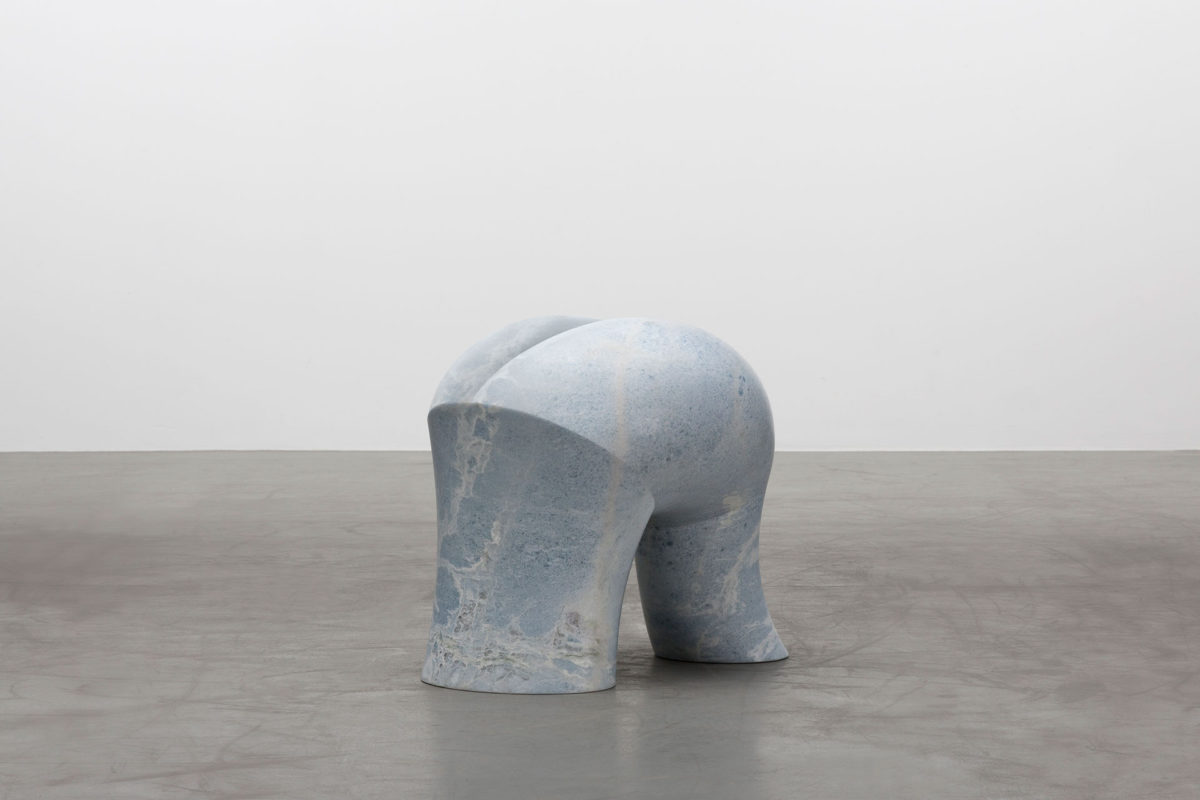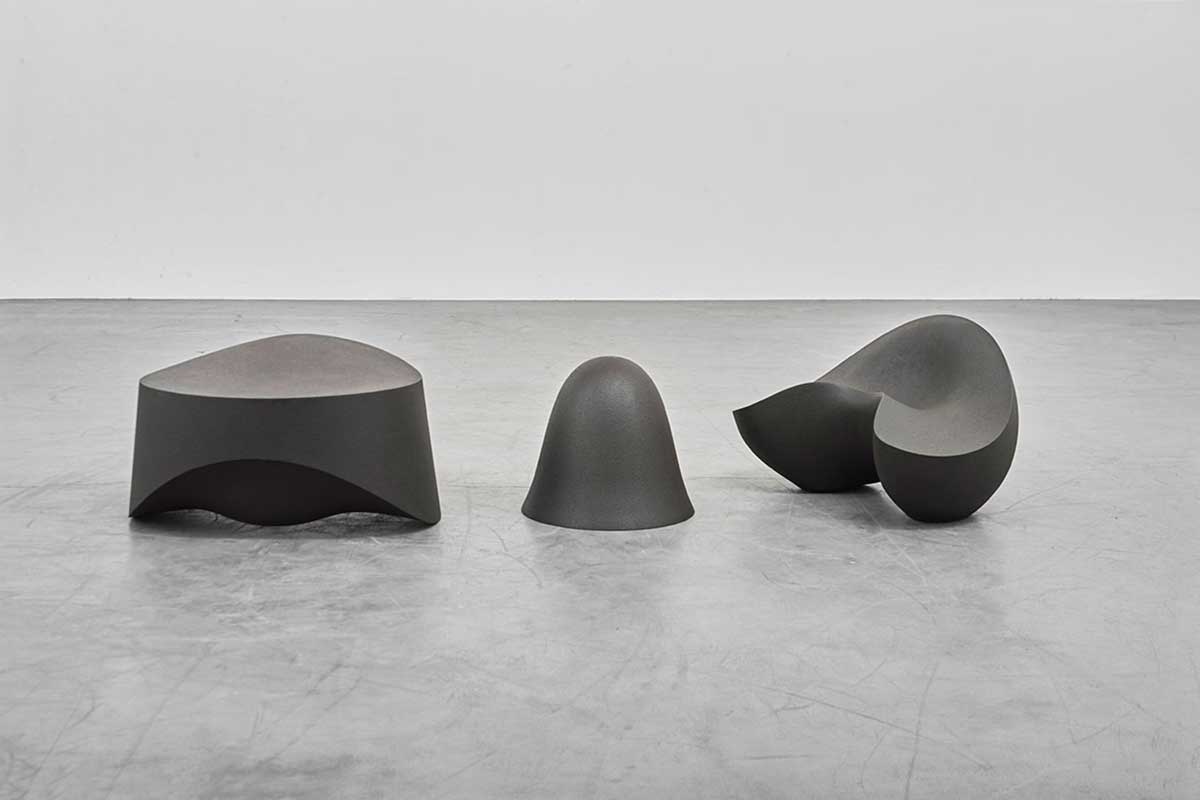Slowing down against the curve of consumerism: the artist talks about the process and the conservation of materials through a niche technique
Aldo Bakker’s practice between art and design
Based in Amsterdam, Aldo Bakker’s practice sits between art and design, toying with archetypes of furniture through sculpture. His exhibition Slow Motion, at the Carpenter’s Workshop Gallery in Paris, refers to both the interaction between his work and audience and his process of making. This series of works is a «family of forms», made of quartzite, marble, onyx, foam and finished with urushi lacquer. Urushi is a thousand-year-old lacquer technique that is still relatively unknown in the West. Harvested from the bark of trees native to East Asia, the brown translucent urushi sap is a natural finishing material. Applied in up to sixty individual layers, each left to dry for a day or two at a time, the process of urushi is one of precision and patience. The material has a variety of aesthetic possibilities but it is noted for its durability and «a specific depth or richness». Urushi Ishimeji is a variation of the technique in which dried and pulverized urushi is added to the lacquer to create a close-grained structure. This makes for a matte finish, less vulnerable to scratches and much stronger. Ishimeji can also be combined with a Maki technique, in which lacquer is added over the pulverized urushi layer, sanded down and polished to a reflective gloss. In his first encounter with urushi, in the form of miso bowls and stackable sets, Aldo Bakker saw «an opportunity in this material and technique». In particular, he «noticed that when you apply it on something with sharp corners, the sharp corner always shines through the lacquer». As demonstrated in his piece Flat Brown, «you get a gradient from a deep concentrated brown to a very light brown on the edge».
Japanese urushi traditional application
Whilst Eileen Gray and other artists before have «made use of this naturally arising effect», this discovery sparked Bakker’s interest and continued exploration of the material. «In the beginning I was like a visitor – making use of this craft, the more interesting it becomes as a world is slowly opening up to me». Aldo Bakker’s studio collaborates with a team of master artisans, as Bakker exclaims, he is «not the expert» on urushi lacquer. His outside perspective has allowed him to push the boundaries of a practice steeped in history. «There are not many other artists that making use of this material in the way that we are doing». In this, he refers to his experimentation with base materials and color. Japanese urushi is traditionally applied onto wood, yet Bakker has employed PIR foam as a base for many pieces in Slow Motion. Wood has «specific qualities» that should not be trapped beneath lacquer, states Bakker. Foam is a «dead material, only serving to give the forms, the shapes and the volume needed» and does not run the risk of movement and a change or crack in the lacquer. In sculptures such as 4prts or Weight / Wait, the foam is rendered unrecognizable beneath the layers of urushi. This is juxtaposed by the application of urushi to aluminium in Flat Brown, highlighting Bakker’s recognition of the versatility of the technique. Aluminium posed particular difficulties as «each material has its own specifics, its own rules and the dialogue between the two materials was not as we wanted it» explained Bakker. Completed between 2014 and 2019, Flat Brown took «great patience and working around the clock, even putting alarms on in the middle of the night to add small layers». The copper colored finished form is natural urushi with no pigment.
Bakker’s use of color more often strays from the traditional brown, red and black of Japanese lacquerware. Whilst he works with Studio Lacquer Decor, and expert Serge, «there’s always a personal angle to the making of a color». The addition of color pigment is late in the process of urushi, giving time for consideration or experimentation. «The interesting thing with this natural lacquer is that it when it ages, it’s getting brighter instead of getting yellowish or dull»; any color, bright orange or dark green, becomes more vibrant over time. This ability to transform over time amplifies the life-span of urushi. From tree sap to a finished gloss, from vulnerable layer to «a coat of armour», it is a preservative with the ability to stand the test of time. There are nine-thousand-year-old objects still preserved with Urushi today. This refusal to dull or wear away speaks to the sustainability of the craft, with Aldo Bakker citing conservation over consumerism. An urushi tree needs to grow at least 10 years before it can be harvested and a lacquered piece takes upwards of six months to complete, feeding back into the title of Slow Motion. This slowing down is prevalent across Aldo Bakker’s. «It is a responsibility of the artist to take time to realize or to be conscious of their materials». To add something to the legacy of urushi, Bakker needed to understand the material’s logic and «this drive to go deeper is literally just asking for more time». This investment of time and consideration is what makes Bakker a dedicated craftsman, and in turn allows each of his sculptures to demand time and attention from an audience. The sculptures seen in Slow Motion are designed individually from instinct or more so as a «reflection of my context», says Bakker. With a background in jewelry design, most of Bakker’s inspiration is from the «cultural or artistic world», and each sculpted shape manages to feel at ease with one another.
Understanding Bakker’s dialogue between characters
The function of pieces, as a stool, table or bench for example, is «only considered if there is room for it», tossing aside the age-old notion of form follows function. Form and material are the guiding tools of his practice. «Scale in my family has a very ambiguous position – I come up with objects that are somehow in-between things». This ambiguity and subversion of furniture design, makes each form difficult to decipher at first glance. The effect of the urushi gloss further plays with reflection, light and color and «you often do not know what it is you’re looking at». It takes time to understand Bakker’s work and the dialogue between characters. In an exhibition space, each viewer is encouraged to act against our fast-paced consumer habits and approach with slowness. «Maybe take a little bit more time and you will discover more; the pleasure or enjoyment could just be more intense», he believes. «I’m so often astonished how quick everything goes around me – there’s such a speed and hunger in the way things are done and put out into the world», expresses Bakker. Weighing in on the coronavirus pandemic, «we’ve led our lives into a direction where we are reactive, we give in to quick fixes. We’re tangled up with this way of life we don’t even have the time or patience to question the value of things and this has consequences». The greater context of Bakker’s practice is that we need to change, or slow down. Whilst it «feels strange just to keep on doing exhibitions as nothing has changed», his work is never really a response to a moment in time or place. The time invested in urushi and its resulting life-span means that the studio produces limited numbers, having a lesser environmental impact. Bakker adds that «When you work with a natural material, like stone, you work with something which already has a past as a history», and his practice seeks to respect and expand upon this history. While it is rarely taught outside of Japan, urushi is not bound to a phase of time and has the potential to enrich modern design. The work of Aldo Bakker and his studio is enriching the history of urushi by taking time to understand the craft and exploring new limits. Bakker has succeeded in conserving and re-awakening the tradition of urushi and, for him. Aldo Bakker’s solo show, Slow Motion, opened at the Carpenter’s Workshop Gallery in Paris in October 2020.
Aldo Bakker
From early on in his career Aldo Bakker (NL, 1971) has produced works in which his use of shape, material and color is balanced with an almost disturbing tenacity in the way these pitchers, bowls, spoons, stools and tables defy everyday perceptions about the relationship between man and object.




















